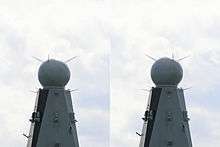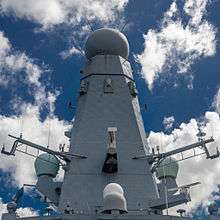SAMPSON
 2012 composite photographed at less than one second interval showing SAMPSON antenna rotation. | |
| Country of origin | United Kingdom |
|---|---|
| Number built | 6 (ordered) |
| Type | Solid-state AESA radar |
| Frequency | 2–4 GHz (S band) |
| Range | 400 km[1] |
| Power | 25 kW |
The SAMPSON is a multi-function dual-face active electronically scanned array radar produced by BAE Systems Maritime. It is the fire control radar component of the Sea Viper naval air defence system. It was previously designated PAAMS(S) to distinguish it from the PAAMS system on the Franco-Italian Horizon Class.
The SAMPSON multi function radar can detect all types of targets out to a distance of 400 km, and is capable of tracking hundreds of targets at any one time. Sea Viper uses this information to assess and command target priorities, and calculate the optimum launch time for its Aster missiles.
History
SAMPSON is derived from the Multi-function Electronically Scanned Adaptive Radar (MESAR) programme. MESAR 1 development commenced in 1982 as a partnership between Plessey, Roke Manor Research and the Defence Evaluation and Research Agency.[2][3] Plessey was acquired by Siemens in 1989 to become Siemens-Plessey, itself acquired by British Aerospace in 1998. British Aerospace became BAE Systems in November 1999. MESAR 1 trials occurred between 1989 and 1994.[2] MESAR 2 development began in August 1995, of which SAMPSON is a derivative.[4]
The Royal Navy intended to deploy the SAMPSON MFR on its version of the Horizon CNGF - a collaboration with France and Italy to produce anti-air warfare frigates. Following delays and complications the UK withdrew and started its own Type 45 programme. The Type 45 destroyers use the SAMPSON radar with the PAAMS missile system, which was also developed for the Horizon frigates (French and Italian ships are to be fitted with the EMPAR MFR). The SAMPSON Radar is made in Cowes, Isle of Wight.
Operation

Conventional radars, consisting of a rotating transmitter and sensor, have limited power, are vulnerable to enemy jamming and perform only one function - with separate units therefore required for surveillance, tracking and targeting.
As an active array, SAMPSON uses software to shape and direct its beam allowing several functions to be carried out at once and, through adaptive waveform control, is virtually immune to enemy jamming. Active arrays have both longer range and higher accuracy than conventional radars. The beam-directing software uses sophisticated algorithms to schedule looks so that the potentially hundreds of active tracks are maintained with maximum accuracy.[5]
The SAMPSON uses two planar arrays to provide coverage over only part of the sky; complete coverage is provided by rotating the arrays, essentially similar to the way conventional radar systems operate. This is in contrast to the US AN/SPY-1 system (as used on the Ticonderoga class cruiser and Arleigh Burke class destroyer) or the Dutch/German/Canadian APAR system (as used on the Royal Dutch Navy's De Zeven Provinciën class frigates, the German Navy's Sachsen class frigates, and the Royal Danish Navy's Ivar Huitfeldt class frigates), which use multiple arrays fixed in place to provide continuous coverage of the entire sky. Whilst this may seem to be a disadvantage, the SAMPSON radar rotates at 30 revolutions per minute, with two back-to-back arrays, meaning no part of the sky lacks coverage for more than one half second on average - the precise time varies as the beams can also be swept back and forth electronically. In addition, the use of a smaller number of arrays allows the system to be much lighter, allowing placement of the arrays at the top of a prominent mast rather than on the side of the superstructure as in the US ships. Placing any radar emitter at higher altitude extends the horizon distance, improving performance against low level targets (see Sea skimming); SAMPSON is at approximately double the height above the waterline than the arrays of its US equivalents. Although precise details of the SAMPSON's performance in this regard are unlikely to enter the public domain, such factors may mitigate the disadvantages of fewer arrays.
BAE Systems have also claimed that Sampson eliminates the need for several separate systems. They suggest that on the Type 45 destroyer, the Alenia Marconi Systems/Signaal [now Thales Nederland] S 1850M long-range 3D radar that is designed to work in partnership with Sampson "really is superfluous and is not needed to perform the mission of the ship". BAE Systems believes that the reason the large volume search radar has been incorporated into PAAMS is "more of a historic nature, associated with [the] work sharing issues" that were a huge problem during the trilateral Project Horizon.
Some tasks are difficult to combine, for example (long range) volume search takes a lot of radar resources, leaving little room for other tasks such as targeting. Combining volume search with other tasks also results either in slow search rates or in low overall quality per task. Driving parameters in radar performance is time-on-target or observation time per beam. This is perhaps a the [sic] key reason why the Royal Navy selected the S1850M Long Range Radar to complement Sampson on the Type 45 destroyers. It is also a reason why NATO in its NATO Anti-Air Warfare System study (NAAWS) defined the preferred AAW system as consisting of a complementary Volume Search Radar and MFR. This - as NATO points out - gives the added advantage that the two systems can use two different radar frequencies; one being a good choice for long range search, the other a good choice for an MFR (which is especially nice as physics makes both tasks difficult to combine).[3]
The performance of both the SAMPSON radar and the PAAMS' Aster missiles will give the Royal Navy an anti-air warfare capability to replace its long serving Type 42 destroyers. The first Type 45, HMS Daring was launched on February 1 2006. The ship was fitted with SAMPSON and S1850M radars in 2007. She underwent trials before being commissioned 23 July 2009.
Modes
- Long and medium-range search
- Surface picture search
- High-speed horizon search
- High-angle search and track
- Multiple target tracking and multiple channel fire control.
See also
- Phased array
- Active electronically scanned array
- Active phased array radar
- AN/SPY-3
- AN/SPY-6
- EL/M-2248 MF-STAR
- OPS-24
- OPS-50
- Selex RAT-31DL
- Selex RAN-40L
- Type 346 Radar
References
- ↑ Dranidis, Dimitris V. (May 2003). "Backboards of the fleet: shipboard phased-array radars; a survey of requirements, technologies, and operational systems". Journal of Electronic Defense. 26 (5): 55.
- 1 2 Gethin, Howard (1999-06-02). "Early warning electronically scanned Radar promises anti-ballistic missile solutions". Flight International. Reed Business Information.
- 1 2 "SAMPSON Multi-Function Radar". Retrieved 2007-08-18.
- ↑ "Fallout from 'StarWars' failure could afflict UK". The Engineer. Centaur Communications. 2000-06-21. p. 17.
- ↑ "Tessella Case Study". Retrieved 2013-11-29.